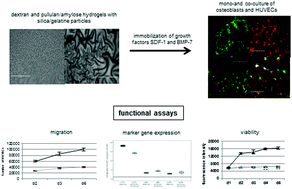Photocrosslinkable polysaccharide hydrogel composites based on dextran or pullulan–amylose blends with cytokines for a human co-culture model of human osteoblasts and endothelial cells†
Abstract
Although a large body of research has been devoted to biomaterial development for bone tissue engineering and related medical disciplines in the last few years, novel and optimized materials especially for bone fractures of critical sizes demand continued development. In this respect, polysaccharide-based hydrogels demonstrate beneficial properties and fulfill the main requirements for a bone tissue scaffold as they are hydrophilic, biocompatible, and biodegradable. The aim of the present study was the development of a natural polysaccharide-based scaffold material that can integrate with the host tissue and support bone regeneration. For this purpose, we prepared and investigated two polymer hydrogel composites of photocrosslinkable derivatives of either pure dextran or a mixture of amylose and pullulan with varying composition. In order to increase their biological activity the swollen hydrogel matrices were compounded with stromal derived growth factor (SDF-1) and bone morphogenic protein (BMP-2). As skeletal development is known to depend on angiogenesis, these hydrogel systems were subjected to mono- and co-culture models of human primary osteoblasts (hOBs) with human endothelial cells (HUVEC – as precursors for blood vessel development). The effect of cytokines on hydrogel-dependent cell behavior was analyzed in the presence and absence of the growth factors SDF-1 and BMP-2. Both the employed cell types grew on all cytokine-modified hydrogel composites, which was assessed by optical microscopy and proliferation assays. Migration assays indicated enhanced HUVEC migration under the influence of SDF-1 and real-time PCR demonstrated an enhanced expression of cell-specific markers for growth factor-modified hydrogels, thus demonstrating their functional bioactivity. Our results demonstrate the fundamental potential of such multi-component polysaccharide hydrogel composites as biomaterials for bone regeneration.



 Please wait while we load your content...
Please wait while we load your content...